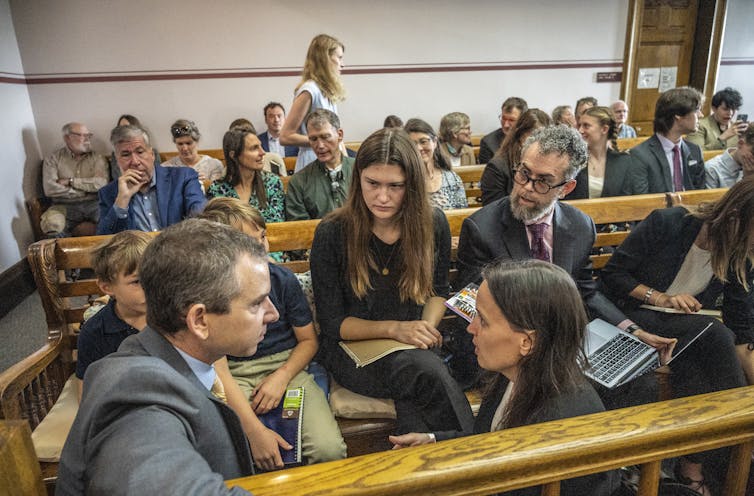Sixteen young Montanans who sued their state over climate change emerged victorious on Aug. 14, 2023, from a first-of-its-kind climate trial.
The case, Held v. State of Montana, was based on allegations that state energy policies violate the young plaintiffs’ constitutional right to “a clean and healthful environment” – a right that has been enshrined in the Montana Constitution since the 1970s. The plaintiffs claimed that state laws promoting fossil fuel extraction and forbidding the consideration of climate impacts during environmental review violate their constitutional environmental right.
Judge Kathy Seeley’s ruling in the youths’ favor sets a powerful precedent for the role of “green amendments” in climate litigation.
The lawsuit, heard in Montana district court, was the first in the U.S. to rely on a state’s constitutional right to a clean and healthful environment to challenge state policies that fuel climate change. In light of the success in Held, it won’t be the last.

What is a green amendment?
The U.S. Constitution does not contain a green amendment, but several state constitutions do.
Pennsylvania, Montana, Hawaii, Massachusetts and Illinois all amended their state constitutions during the environmental movement of the 1970s to recognize the people’s right to a clean and healthful environment. Because these green amendments are constitutional provisions, they function as limits on what government can do.
Early cases in Pennsylvania and Illinois testing these newly recognized constitutional rights saw little success. By the 1990s, the Illinois Supreme Court had eviscerated Illinois’ green amendment, concluding that the environmental right did not provide a basis upon which a citizen could bring a lawsuit.
In 1999, however, when green amendments were all but forgotten, a single case in Montana quietly vindicated Montanans’ constitutional right to a clean and healthful environment.
It was brought by local environmental groups over water quality concerns at a proposed gold mine. At that time, Montana’s environmental laws allowed the state to issue permits for projects that would discharge pollutants into Montana waters without conducting any environmental review. The Montana Supreme Court determined that such a law violated Montanans’ fundamental right to a clean and healthful environment and was unconstitutional.

The next green amendment success took 14 years and occurred in Pennsylvania. In the early 2010s, Pennsylvania enacted a state law that gave the oil and gas industry the right to commence hydraulic fracturing, or fracking, anywhere in the state. This law prevented local governments from making land use decisions to restrict or limit fracking in their jurisdictions. The Pennsylvania Supreme Court struck down this state law as violating Pennsylvanians’ constitutional right to a clean and healthful environment.
That Pennsylvania decision ignited an explosion of interest in green amendments.
In Hawaii, public interest groups began challenging the state’s approval of carbon-intensive electricity generation on the ground that it violates Hawaiians’ right to a clean and healthful environment. The state now relies on its green amendment to reject new carbon-intensive electricity sources for powering Hawaii.
In 2022, New York became the first state since the 1970s to adopt a green amendment. Currently, Arizona, Connecticut, Iowa, Kentucky, Maine, Nevada, New Jersey, New Mexico, Tennessee, Texas, Vermont, Washington, and West Virginia are considering adopting green amendments.
Success in Montana
Based on the extensive scientific evidence presented at the trial in June, Judge Seeley found that the Montana youth are being harmed by climate change occurring in Montana and that those climate change effects can be attributed to the state law the plaintiffs challenged.
Seeley also determined that declaring the state law forbidding the consideration of climate impacts during environmental review unconstitutional would alleviate further harm to the youth. On these grounds, she struck down the state law as unconstitutional.
This result sets a groundbreaking precedent for climate litigation and demonstrates a new way in which green amendments can be invoked to elicit environmental change. It suggests that in other states with green amendments, state laws cannot forbid the consideration of greenhouse gas emissions and their climate impact during environmental review.

However, Seeley made it clear long before trial that she does not have the power to order the state to create a remedial plan to address climate change.
Further, the Montana legislature repealed the state policies promoting fossil fuel extraction just two months before the trial began, and a judge cannot generally rule on the constitutionality of a repealed law. So, whether state policies promoting fossil fuel extraction violate the people’s constitutional right to a clean and healthful environment is a question for another day and another case.
A spokeswoman for Montana’s attorney general said the state plans to appeal Seeley’s ruling.
Impact on federal climate litigation
It is unclear how the Montana youths’ victory will influence federal climate litigation. The federal youth climate case Juliana v. United States, which was recently revived, relies on the Fifth and Ninth amendments to the U.S. Constitution, as well as the common law public trust doctrine. Neither the Fifth Amendment nor the Ninth Amendment is considered environmental rights akin to a green amendment. However, the public trust doctrine has been relevant in some states’ green amendment jurisprudence.
In the states that have green amendments, climate advocates will certainly rely on the Montana youth case as they challenge state laws that promote climate change.
In recent years, we have witnessed an erosion of our environmental laws through politics and the courts. That has fueled new legal claims of environmental rights in the U.S., Canada and other countries.
This phenomenon is the focus of my research, of which green amendments are just a part. I believe we will continue to see cases, like Held v. State of Montana, invoke rights-based approaches to tackle environmental problems in the future.


